NURSING ASSIGNMENT 9: Hand Hygiene Effectiveness in Infection Control
VerifiedAdded on 2021/04/24
|14
|3506
|73
Report
AI Summary
This nursing assignment report delves into the critical importance of infection control and prevention practices, specifically focusing on the effectiveness of hand hygiene in preventing hospital-acquired infections (HAIs). The research underscores the significance of hand washing in reducing the spread of microorganisms and maintaining a safe healthcare environment for patients, healthcare providers, and visitors. The study employs a systematic review approach, analyzing various research articles and guidelines from sources like Cochrane Library and PubMed to establish the correlation between hand hygiene practices and reduced infection rates. It also examines the implementation of hand hygiene programs, the impact of educational interventions, and the importance of readily available hand sanitizers. The conclusion emphasizes that adherence to proper hand washing techniques and guidelines, coupled with appropriate training, significantly contributes to controlling infection rates, preventing bacterial colonization, and improving overall healthcare quality, highlighting the crucial role of nurses in promoting and implementing these practices.
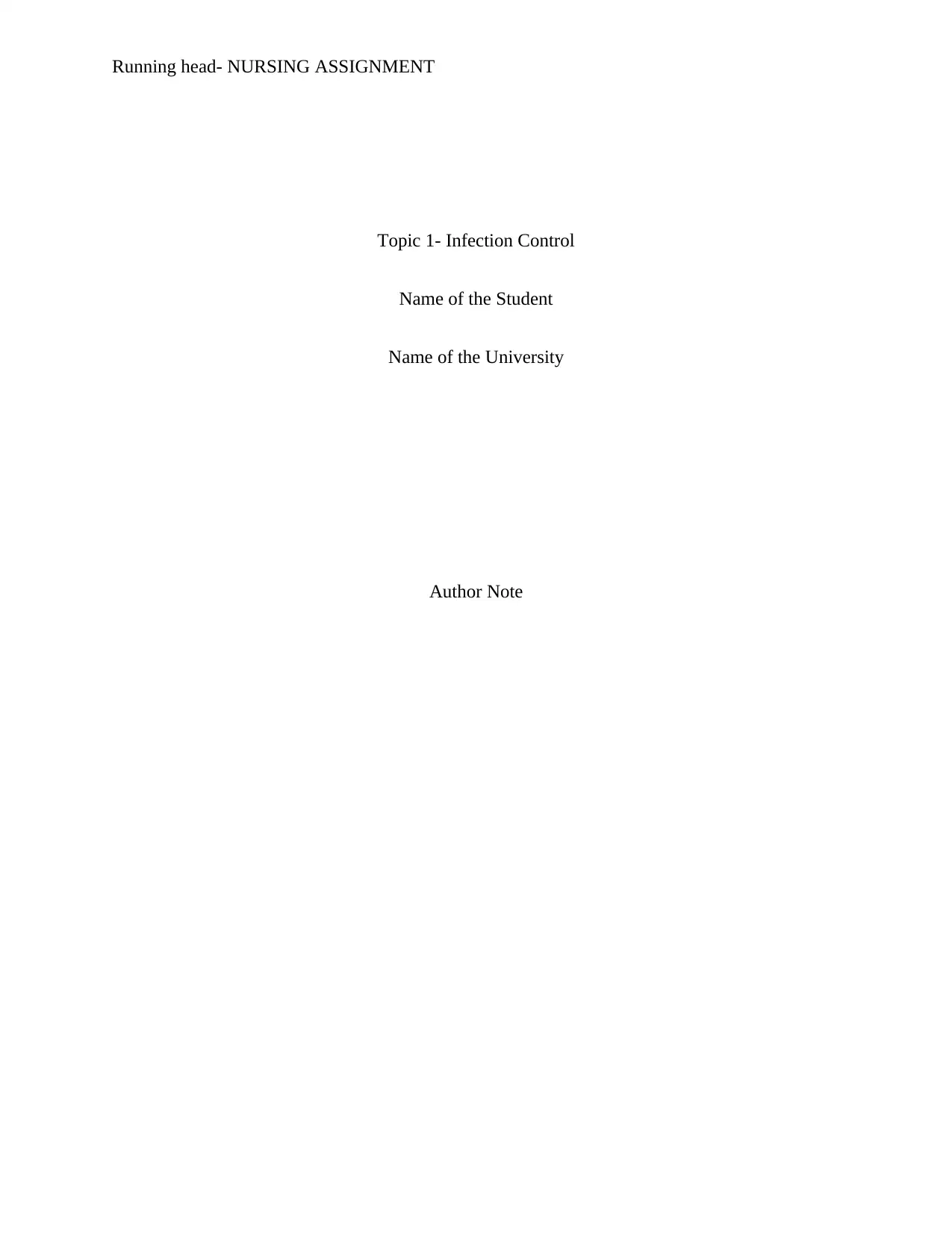
Running head- NURSING ASSIGNMENT
Topic 1- Infection Control
Name of the Student
Name of the University
Author Note
Topic 1- Infection Control
Name of the Student
Name of the University
Author Note
Paraphrase This Document
Need a fresh take? Get an instant paraphrase of this document with our AI Paraphraser
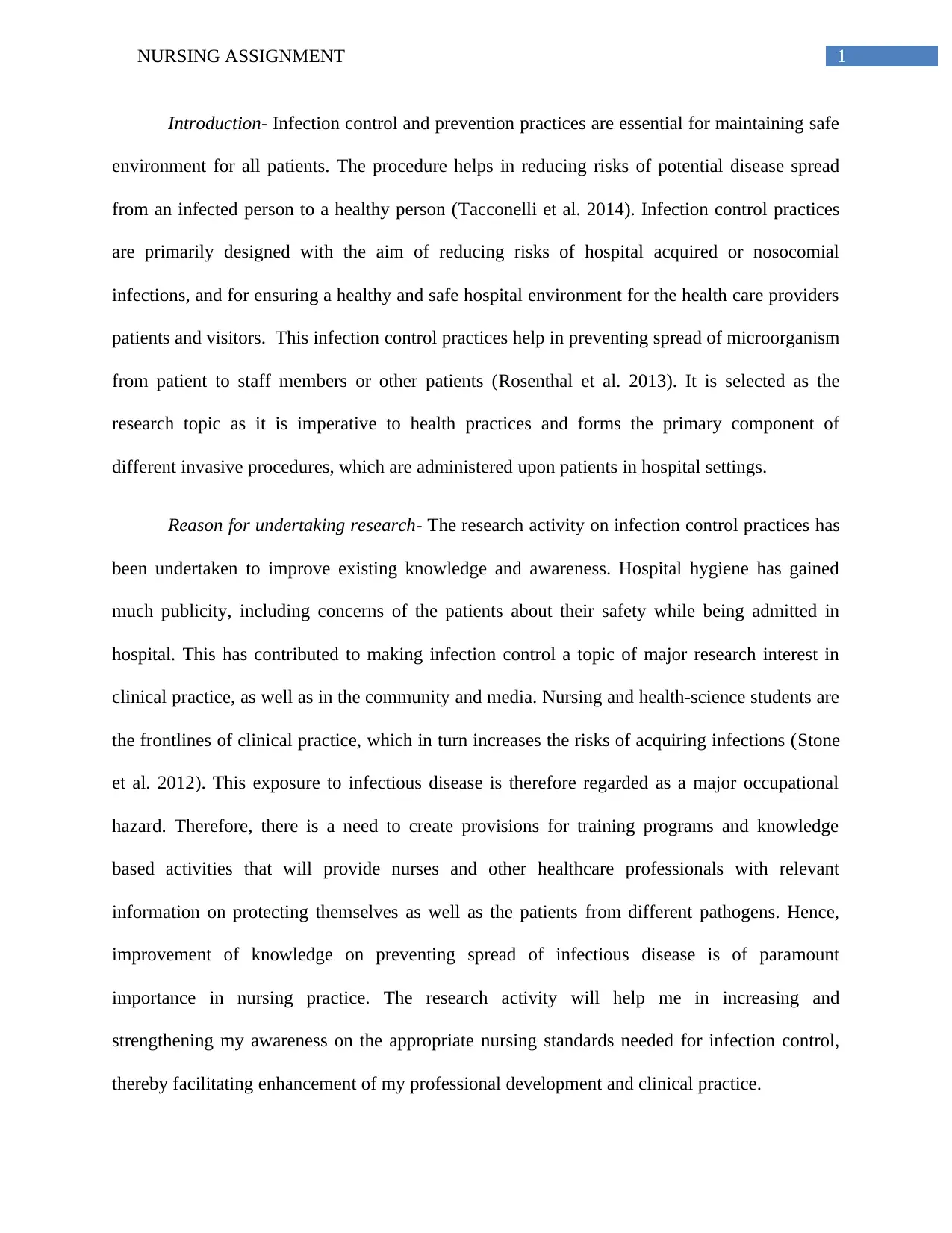
1NURSING ASSIGNMENT
Introduction- Infection control and prevention practices are essential for maintaining safe
environment for all patients. The procedure helps in reducing risks of potential disease spread
from an infected person to a healthy person (Tacconelli et al. 2014). Infection control practices
are primarily designed with the aim of reducing risks of hospital acquired or nosocomial
infections, and for ensuring a healthy and safe hospital environment for the health care providers
patients and visitors. This infection control practices help in preventing spread of microorganism
from patient to staff members or other patients (Rosenthal et al. 2013). It is selected as the
research topic as it is imperative to health practices and forms the primary component of
different invasive procedures, which are administered upon patients in hospital settings.
Reason for undertaking research- The research activity on infection control practices has
been undertaken to improve existing knowledge and awareness. Hospital hygiene has gained
much publicity, including concerns of the patients about their safety while being admitted in
hospital. This has contributed to making infection control a topic of major research interest in
clinical practice, as well as in the community and media. Nursing and health-science students are
the frontlines of clinical practice, which in turn increases the risks of acquiring infections (Stone
et al. 2012). This exposure to infectious disease is therefore regarded as a major occupational
hazard. Therefore, there is a need to create provisions for training programs and knowledge
based activities that will provide nurses and other healthcare professionals with relevant
information on protecting themselves as well as the patients from different pathogens. Hence,
improvement of knowledge on preventing spread of infectious disease is of paramount
importance in nursing practice. The research activity will help me in increasing and
strengthening my awareness on the appropriate nursing standards needed for infection control,
thereby facilitating enhancement of my professional development and clinical practice.
Introduction- Infection control and prevention practices are essential for maintaining safe
environment for all patients. The procedure helps in reducing risks of potential disease spread
from an infected person to a healthy person (Tacconelli et al. 2014). Infection control practices
are primarily designed with the aim of reducing risks of hospital acquired or nosocomial
infections, and for ensuring a healthy and safe hospital environment for the health care providers
patients and visitors. This infection control practices help in preventing spread of microorganism
from patient to staff members or other patients (Rosenthal et al. 2013). It is selected as the
research topic as it is imperative to health practices and forms the primary component of
different invasive procedures, which are administered upon patients in hospital settings.
Reason for undertaking research- The research activity on infection control practices has
been undertaken to improve existing knowledge and awareness. Hospital hygiene has gained
much publicity, including concerns of the patients about their safety while being admitted in
hospital. This has contributed to making infection control a topic of major research interest in
clinical practice, as well as in the community and media. Nursing and health-science students are
the frontlines of clinical practice, which in turn increases the risks of acquiring infections (Stone
et al. 2012). This exposure to infectious disease is therefore regarded as a major occupational
hazard. Therefore, there is a need to create provisions for training programs and knowledge
based activities that will provide nurses and other healthcare professionals with relevant
information on protecting themselves as well as the patients from different pathogens. Hence,
improvement of knowledge on preventing spread of infectious disease is of paramount
importance in nursing practice. The research activity will help me in increasing and
strengthening my awareness on the appropriate nursing standards needed for infection control,
thereby facilitating enhancement of my professional development and clinical practice.
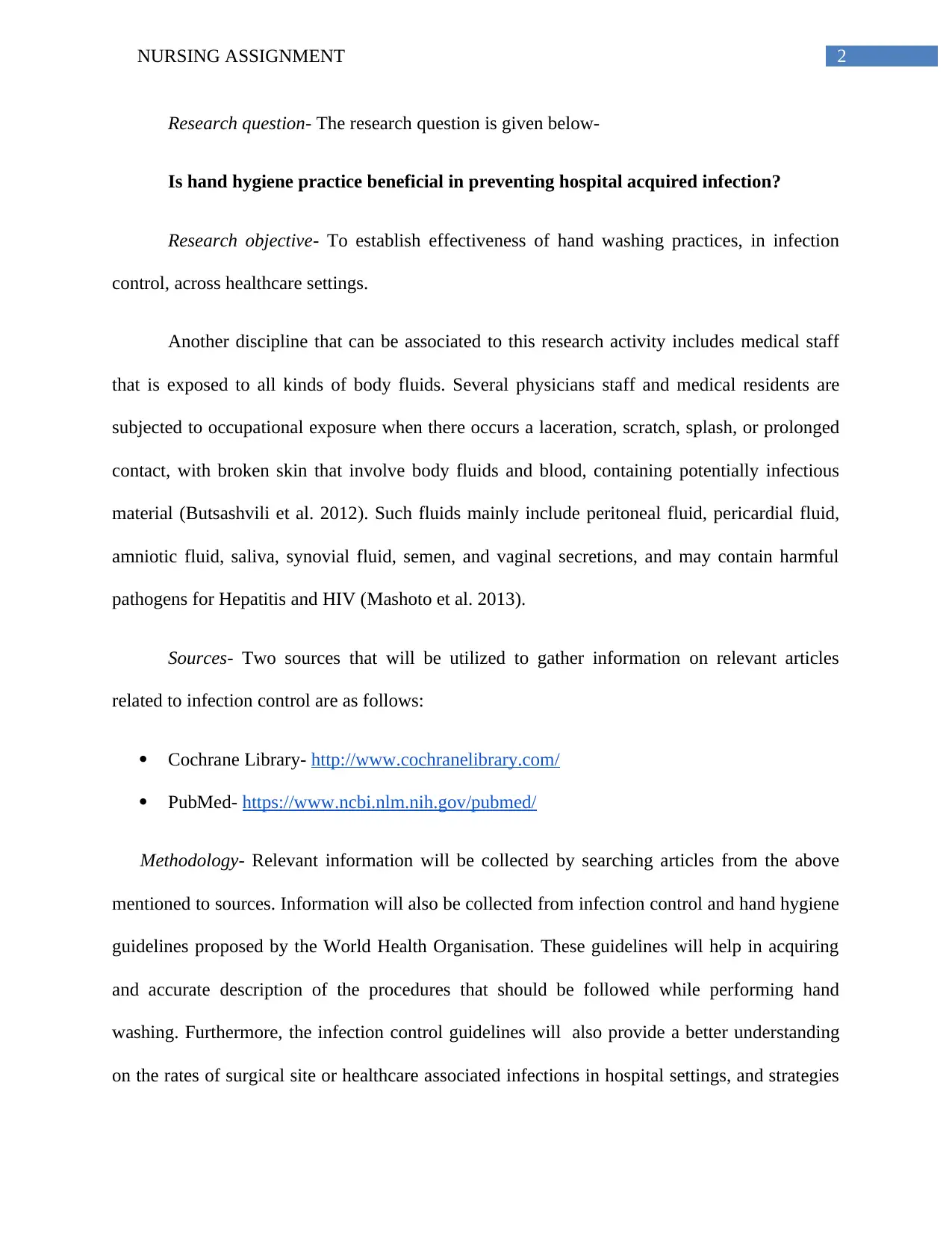
2NURSING ASSIGNMENT
Research question- The research question is given below-
Is hand hygiene practice beneficial in preventing hospital acquired infection?
Research objective- To establish effectiveness of hand washing practices, in infection
control, across healthcare settings.
Another discipline that can be associated to this research activity includes medical staff
that is exposed to all kinds of body fluids. Several physicians staff and medical residents are
subjected to occupational exposure when there occurs a laceration, scratch, splash, or prolonged
contact, with broken skin that involve body fluids and blood, containing potentially infectious
material (Butsashvili et al. 2012). Such fluids mainly include peritoneal fluid, pericardial fluid,
amniotic fluid, saliva, synovial fluid, semen, and vaginal secretions, and may contain harmful
pathogens for Hepatitis and HIV (Mashoto et al. 2013).
Sources- Two sources that will be utilized to gather information on relevant articles
related to infection control are as follows:
Cochrane Library- http://www.cochranelibrary.com/
PubMed- https://www.ncbi.nlm.nih.gov/pubmed/
Methodology- Relevant information will be collected by searching articles from the above
mentioned to sources. Information will also be collected from infection control and hand hygiene
guidelines proposed by the World Health Organisation. These guidelines will help in acquiring
and accurate description of the procedures that should be followed while performing hand
washing. Furthermore, the infection control guidelines will also provide a better understanding
on the rates of surgical site or healthcare associated infections in hospital settings, and strategies
Research question- The research question is given below-
Is hand hygiene practice beneficial in preventing hospital acquired infection?
Research objective- To establish effectiveness of hand washing practices, in infection
control, across healthcare settings.
Another discipline that can be associated to this research activity includes medical staff
that is exposed to all kinds of body fluids. Several physicians staff and medical residents are
subjected to occupational exposure when there occurs a laceration, scratch, splash, or prolonged
contact, with broken skin that involve body fluids and blood, containing potentially infectious
material (Butsashvili et al. 2012). Such fluids mainly include peritoneal fluid, pericardial fluid,
amniotic fluid, saliva, synovial fluid, semen, and vaginal secretions, and may contain harmful
pathogens for Hepatitis and HIV (Mashoto et al. 2013).
Sources- Two sources that will be utilized to gather information on relevant articles
related to infection control are as follows:
Cochrane Library- http://www.cochranelibrary.com/
PubMed- https://www.ncbi.nlm.nih.gov/pubmed/
Methodology- Relevant information will be collected by searching articles from the above
mentioned to sources. Information will also be collected from infection control and hand hygiene
guidelines proposed by the World Health Organisation. These guidelines will help in acquiring
and accurate description of the procedures that should be followed while performing hand
washing. Furthermore, the infection control guidelines will also provide a better understanding
on the rates of surgical site or healthcare associated infections in hospital settings, and strategies
⊘ This is a preview!⊘
Do you want full access?
Subscribe today to unlock all pages.

Trusted by 1+ million students worldwide
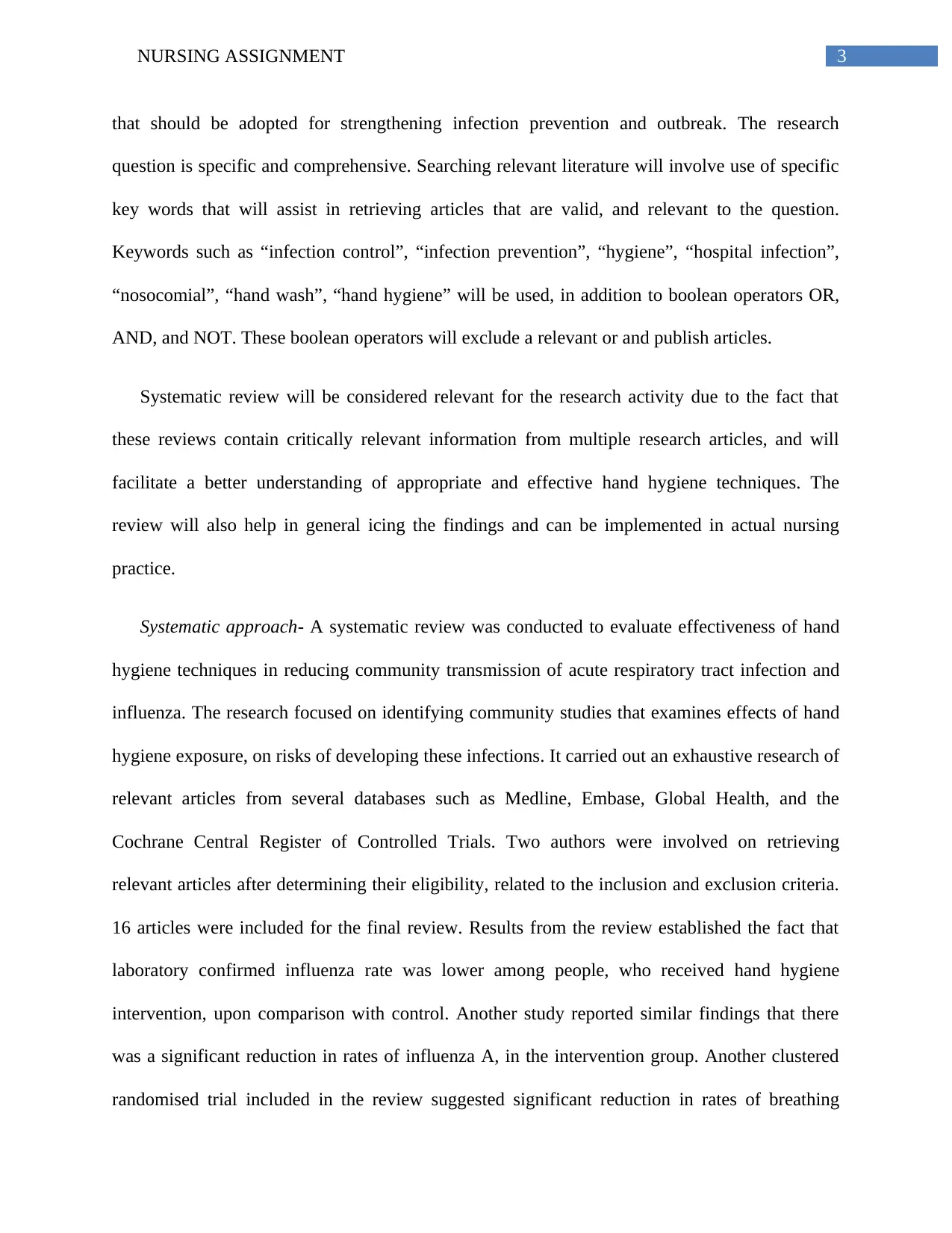
3NURSING ASSIGNMENT
that should be adopted for strengthening infection prevention and outbreak. The research
question is specific and comprehensive. Searching relevant literature will involve use of specific
key words that will assist in retrieving articles that are valid, and relevant to the question.
Keywords such as “infection control”, “infection prevention”, “hygiene”, “hospital infection”,
“nosocomial”, “hand wash”, “hand hygiene” will be used, in addition to boolean operators OR,
AND, and NOT. These boolean operators will exclude a relevant or and publish articles.
Systematic review will be considered relevant for the research activity due to the fact that
these reviews contain critically relevant information from multiple research articles, and will
facilitate a better understanding of appropriate and effective hand hygiene techniques. The
review will also help in general icing the findings and can be implemented in actual nursing
practice.
Systematic approach- A systematic review was conducted to evaluate effectiveness of hand
hygiene techniques in reducing community transmission of acute respiratory tract infection and
influenza. The research focused on identifying community studies that examines effects of hand
hygiene exposure, on risks of developing these infections. It carried out an exhaustive research of
relevant articles from several databases such as Medline, Embase, Global Health, and the
Cochrane Central Register of Controlled Trials. Two authors were involved on retrieving
relevant articles after determining their eligibility, related to the inclusion and exclusion criteria.
16 articles were included for the final review. Results from the review established the fact that
laboratory confirmed influenza rate was lower among people, who received hand hygiene
intervention, upon comparison with control. Another study reported similar findings that there
was a significant reduction in rates of influenza A, in the intervention group. Another clustered
randomised trial included in the review suggested significant reduction in rates of breathing
that should be adopted for strengthening infection prevention and outbreak. The research
question is specific and comprehensive. Searching relevant literature will involve use of specific
key words that will assist in retrieving articles that are valid, and relevant to the question.
Keywords such as “infection control”, “infection prevention”, “hygiene”, “hospital infection”,
“nosocomial”, “hand wash”, “hand hygiene” will be used, in addition to boolean operators OR,
AND, and NOT. These boolean operators will exclude a relevant or and publish articles.
Systematic review will be considered relevant for the research activity due to the fact that
these reviews contain critically relevant information from multiple research articles, and will
facilitate a better understanding of appropriate and effective hand hygiene techniques. The
review will also help in general icing the findings and can be implemented in actual nursing
practice.
Systematic approach- A systematic review was conducted to evaluate effectiveness of hand
hygiene techniques in reducing community transmission of acute respiratory tract infection and
influenza. The research focused on identifying community studies that examines effects of hand
hygiene exposure, on risks of developing these infections. It carried out an exhaustive research of
relevant articles from several databases such as Medline, Embase, Global Health, and the
Cochrane Central Register of Controlled Trials. Two authors were involved on retrieving
relevant articles after determining their eligibility, related to the inclusion and exclusion criteria.
16 articles were included for the final review. Results from the review established the fact that
laboratory confirmed influenza rate was lower among people, who received hand hygiene
intervention, upon comparison with control. Another study reported similar findings that there
was a significant reduction in rates of influenza A, in the intervention group. Another clustered
randomised trial included in the review suggested significant reduction in rates of breathing
Paraphrase This Document
Need a fresh take? Get an instant paraphrase of this document with our AI Paraphraser
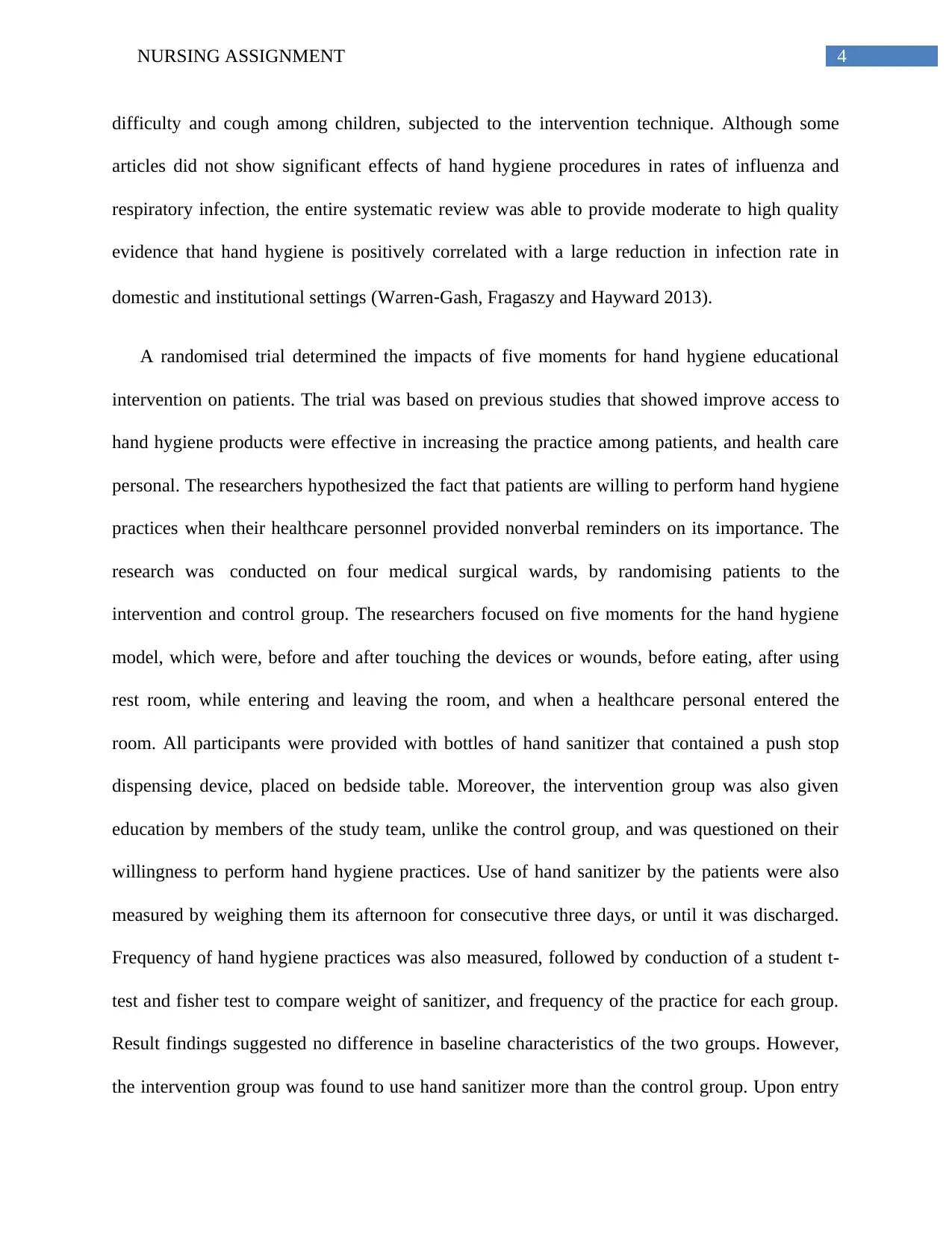
4NURSING ASSIGNMENT
difficulty and cough among children, subjected to the intervention technique. Although some
articles did not show significant effects of hand hygiene procedures in rates of influenza and
respiratory infection, the entire systematic review was able to provide moderate to high quality
evidence that hand hygiene is positively correlated with a large reduction in infection rate in
domestic and institutional settings (Warren‐Gash, Fragaszy and Hayward 2013).
A randomised trial determined the impacts of five moments for hand hygiene educational
intervention on patients. The trial was based on previous studies that showed improve access to
hand hygiene products were effective in increasing the practice among patients, and health care
personal. The researchers hypothesized the fact that patients are willing to perform hand hygiene
practices when their healthcare personnel provided nonverbal reminders on its importance. The
research was conducted on four medical surgical wards, by randomising patients to the
intervention and control group. The researchers focused on five moments for the hand hygiene
model, which were, before and after touching the devices or wounds, before eating, after using
rest room, while entering and leaving the room, and when a healthcare personal entered the
room. All participants were provided with bottles of hand sanitizer that contained a push stop
dispensing device, placed on bedside table. Moreover, the intervention group was also given
education by members of the study team, unlike the control group, and was questioned on their
willingness to perform hand hygiene practices. Use of hand sanitizer by the patients were also
measured by weighing them its afternoon for consecutive three days, or until it was discharged.
Frequency of hand hygiene practices was also measured, followed by conduction of a student t-
test and fisher test to compare weight of sanitizer, and frequency of the practice for each group.
Result findings suggested no difference in baseline characteristics of the two groups. However,
the intervention group was found to use hand sanitizer more than the control group. Upon entry
difficulty and cough among children, subjected to the intervention technique. Although some
articles did not show significant effects of hand hygiene procedures in rates of influenza and
respiratory infection, the entire systematic review was able to provide moderate to high quality
evidence that hand hygiene is positively correlated with a large reduction in infection rate in
domestic and institutional settings (Warren‐Gash, Fragaszy and Hayward 2013).
A randomised trial determined the impacts of five moments for hand hygiene educational
intervention on patients. The trial was based on previous studies that showed improve access to
hand hygiene products were effective in increasing the practice among patients, and health care
personal. The researchers hypothesized the fact that patients are willing to perform hand hygiene
practices when their healthcare personnel provided nonverbal reminders on its importance. The
research was conducted on four medical surgical wards, by randomising patients to the
intervention and control group. The researchers focused on five moments for the hand hygiene
model, which were, before and after touching the devices or wounds, before eating, after using
rest room, while entering and leaving the room, and when a healthcare personal entered the
room. All participants were provided with bottles of hand sanitizer that contained a push stop
dispensing device, placed on bedside table. Moreover, the intervention group was also given
education by members of the study team, unlike the control group, and was questioned on their
willingness to perform hand hygiene practices. Use of hand sanitizer by the patients were also
measured by weighing them its afternoon for consecutive three days, or until it was discharged.
Frequency of hand hygiene practices was also measured, followed by conduction of a student t-
test and fisher test to compare weight of sanitizer, and frequency of the practice for each group.
Result findings suggested no difference in baseline characteristics of the two groups. However,
the intervention group was found to use hand sanitizer more than the control group. Upon entry
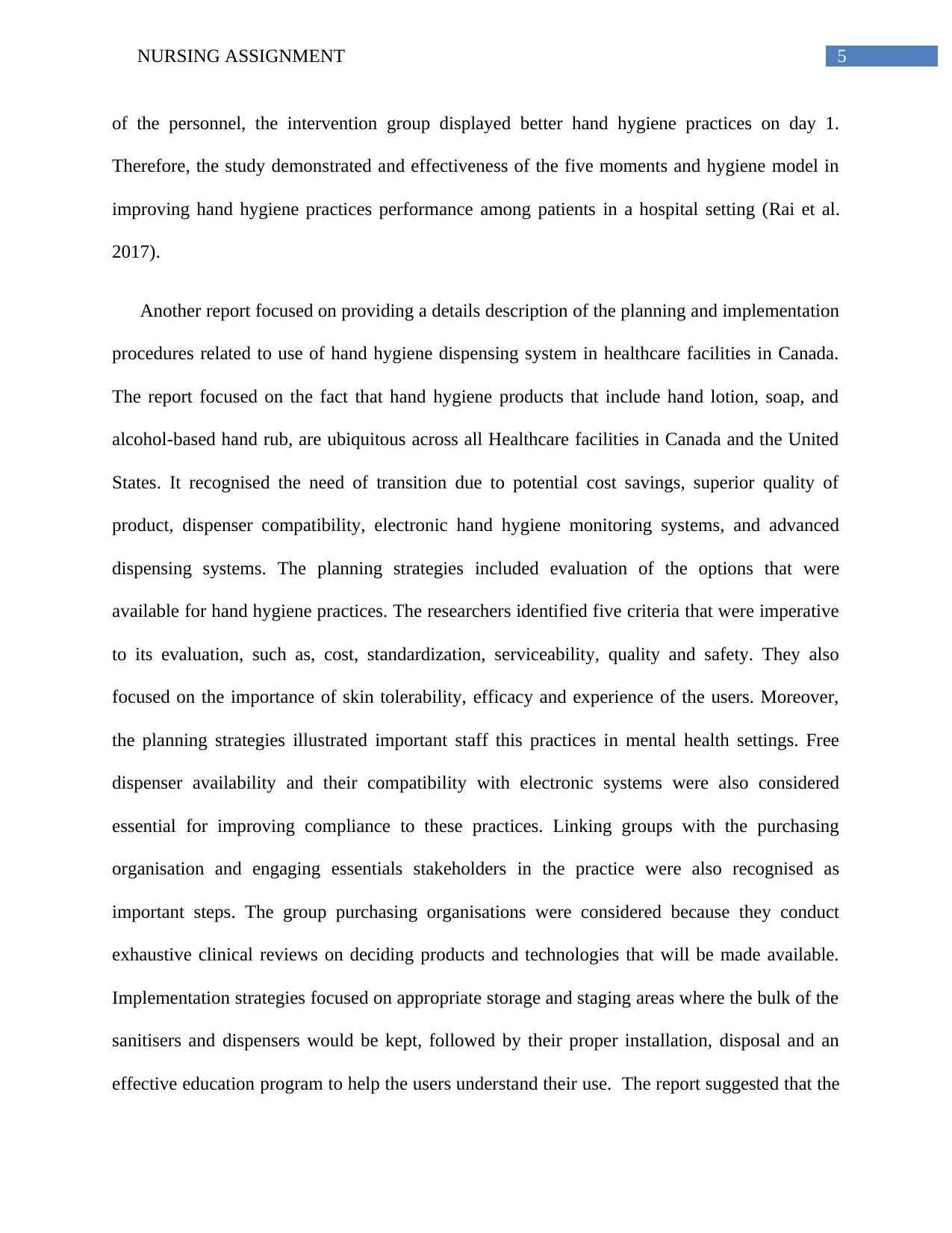
5NURSING ASSIGNMENT
of the personnel, the intervention group displayed better hand hygiene practices on day 1.
Therefore, the study demonstrated and effectiveness of the five moments and hygiene model in
improving hand hygiene practices performance among patients in a hospital setting (Rai et al.
2017).
Another report focused on providing a details description of the planning and implementation
procedures related to use of hand hygiene dispensing system in healthcare facilities in Canada.
The report focused on the fact that hand hygiene products that include hand lotion, soap, and
alcohol-based hand rub, are ubiquitous across all Healthcare facilities in Canada and the United
States. It recognised the need of transition due to potential cost savings, superior quality of
product, dispenser compatibility, electronic hand hygiene monitoring systems, and advanced
dispensing systems. The planning strategies included evaluation of the options that were
available for hand hygiene practices. The researchers identified five criteria that were imperative
to its evaluation, such as, cost, standardization, serviceability, quality and safety. They also
focused on the importance of skin tolerability, efficacy and experience of the users. Moreover,
the planning strategies illustrated important staff this practices in mental health settings. Free
dispenser availability and their compatibility with electronic systems were also considered
essential for improving compliance to these practices. Linking groups with the purchasing
organisation and engaging essentials stakeholders in the practice were also recognised as
important steps. The group purchasing organisations were considered because they conduct
exhaustive clinical reviews on deciding products and technologies that will be made available.
Implementation strategies focused on appropriate storage and staging areas where the bulk of the
sanitisers and dispensers would be kept, followed by their proper installation, disposal and an
effective education program to help the users understand their use. The report suggested that the
of the personnel, the intervention group displayed better hand hygiene practices on day 1.
Therefore, the study demonstrated and effectiveness of the five moments and hygiene model in
improving hand hygiene practices performance among patients in a hospital setting (Rai et al.
2017).
Another report focused on providing a details description of the planning and implementation
procedures related to use of hand hygiene dispensing system in healthcare facilities in Canada.
The report focused on the fact that hand hygiene products that include hand lotion, soap, and
alcohol-based hand rub, are ubiquitous across all Healthcare facilities in Canada and the United
States. It recognised the need of transition due to potential cost savings, superior quality of
product, dispenser compatibility, electronic hand hygiene monitoring systems, and advanced
dispensing systems. The planning strategies included evaluation of the options that were
available for hand hygiene practices. The researchers identified five criteria that were imperative
to its evaluation, such as, cost, standardization, serviceability, quality and safety. They also
focused on the importance of skin tolerability, efficacy and experience of the users. Moreover,
the planning strategies illustrated important staff this practices in mental health settings. Free
dispenser availability and their compatibility with electronic systems were also considered
essential for improving compliance to these practices. Linking groups with the purchasing
organisation and engaging essentials stakeholders in the practice were also recognised as
important steps. The group purchasing organisations were considered because they conduct
exhaustive clinical reviews on deciding products and technologies that will be made available.
Implementation strategies focused on appropriate storage and staging areas where the bulk of the
sanitisers and dispensers would be kept, followed by their proper installation, disposal and an
effective education program to help the users understand their use. The report suggested that the
⊘ This is a preview!⊘
Do you want full access?
Subscribe today to unlock all pages.

Trusted by 1+ million students worldwide
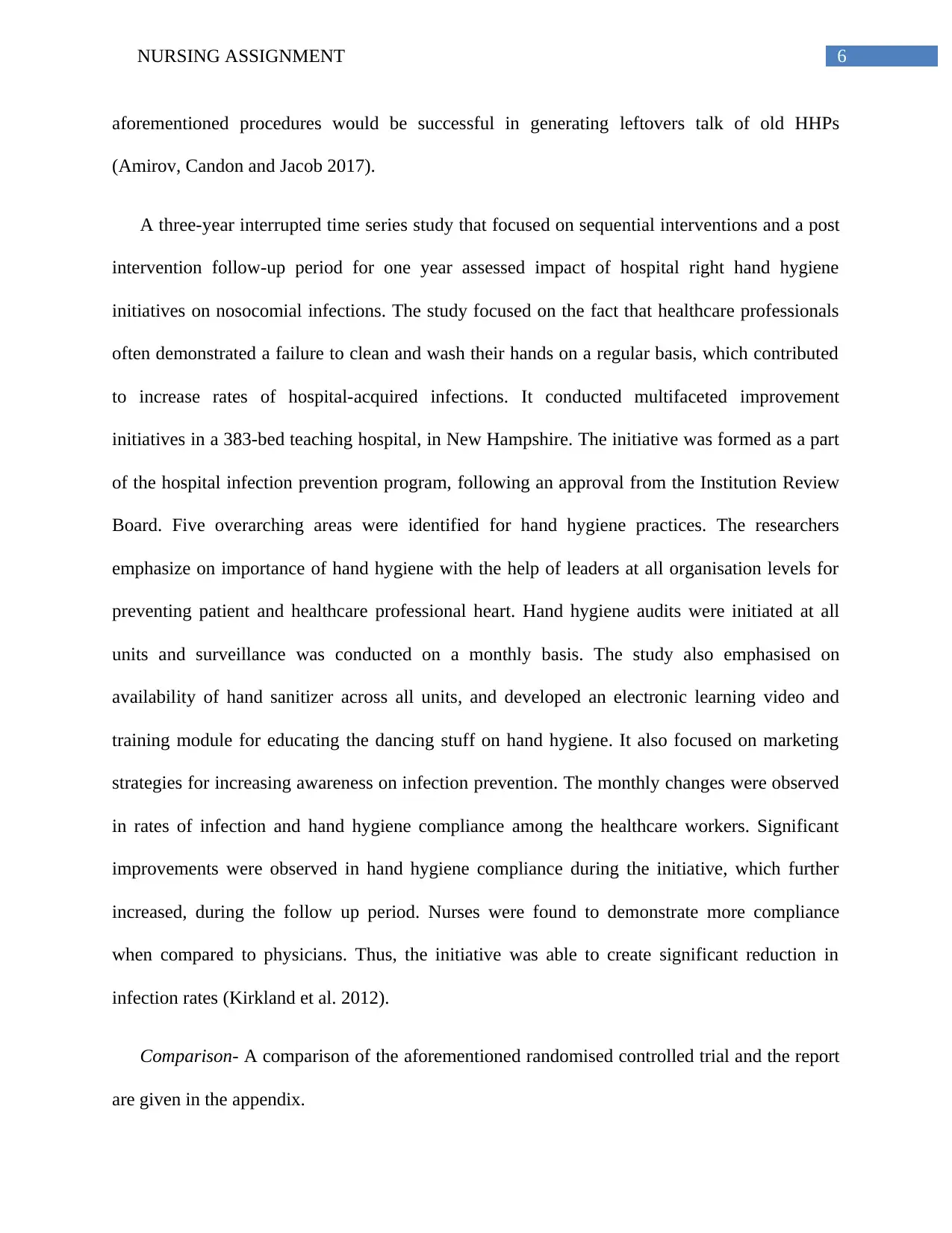
6NURSING ASSIGNMENT
aforementioned procedures would be successful in generating leftovers talk of old HHPs
(Amirov, Candon and Jacob 2017).
A three-year interrupted time series study that focused on sequential interventions and a post
intervention follow-up period for one year assessed impact of hospital right hand hygiene
initiatives on nosocomial infections. The study focused on the fact that healthcare professionals
often demonstrated a failure to clean and wash their hands on a regular basis, which contributed
to increase rates of hospital-acquired infections. It conducted multifaceted improvement
initiatives in a 383-bed teaching hospital, in New Hampshire. The initiative was formed as a part
of the hospital infection prevention program, following an approval from the Institution Review
Board. Five overarching areas were identified for hand hygiene practices. The researchers
emphasize on importance of hand hygiene with the help of leaders at all organisation levels for
preventing patient and healthcare professional heart. Hand hygiene audits were initiated at all
units and surveillance was conducted on a monthly basis. The study also emphasised on
availability of hand sanitizer across all units, and developed an electronic learning video and
training module for educating the dancing stuff on hand hygiene. It also focused on marketing
strategies for increasing awareness on infection prevention. The monthly changes were observed
in rates of infection and hand hygiene compliance among the healthcare workers. Significant
improvements were observed in hand hygiene compliance during the initiative, which further
increased, during the follow up period. Nurses were found to demonstrate more compliance
when compared to physicians. Thus, the initiative was able to create significant reduction in
infection rates (Kirkland et al. 2012).
Comparison- A comparison of the aforementioned randomised controlled trial and the report
are given in the appendix.
aforementioned procedures would be successful in generating leftovers talk of old HHPs
(Amirov, Candon and Jacob 2017).
A three-year interrupted time series study that focused on sequential interventions and a post
intervention follow-up period for one year assessed impact of hospital right hand hygiene
initiatives on nosocomial infections. The study focused on the fact that healthcare professionals
often demonstrated a failure to clean and wash their hands on a regular basis, which contributed
to increase rates of hospital-acquired infections. It conducted multifaceted improvement
initiatives in a 383-bed teaching hospital, in New Hampshire. The initiative was formed as a part
of the hospital infection prevention program, following an approval from the Institution Review
Board. Five overarching areas were identified for hand hygiene practices. The researchers
emphasize on importance of hand hygiene with the help of leaders at all organisation levels for
preventing patient and healthcare professional heart. Hand hygiene audits were initiated at all
units and surveillance was conducted on a monthly basis. The study also emphasised on
availability of hand sanitizer across all units, and developed an electronic learning video and
training module for educating the dancing stuff on hand hygiene. It also focused on marketing
strategies for increasing awareness on infection prevention. The monthly changes were observed
in rates of infection and hand hygiene compliance among the healthcare workers. Significant
improvements were observed in hand hygiene compliance during the initiative, which further
increased, during the follow up period. Nurses were found to demonstrate more compliance
when compared to physicians. Thus, the initiative was able to create significant reduction in
infection rates (Kirkland et al. 2012).
Comparison- A comparison of the aforementioned randomised controlled trial and the report
are given in the appendix.
Paraphrase This Document
Need a fresh take? Get an instant paraphrase of this document with our AI Paraphraser
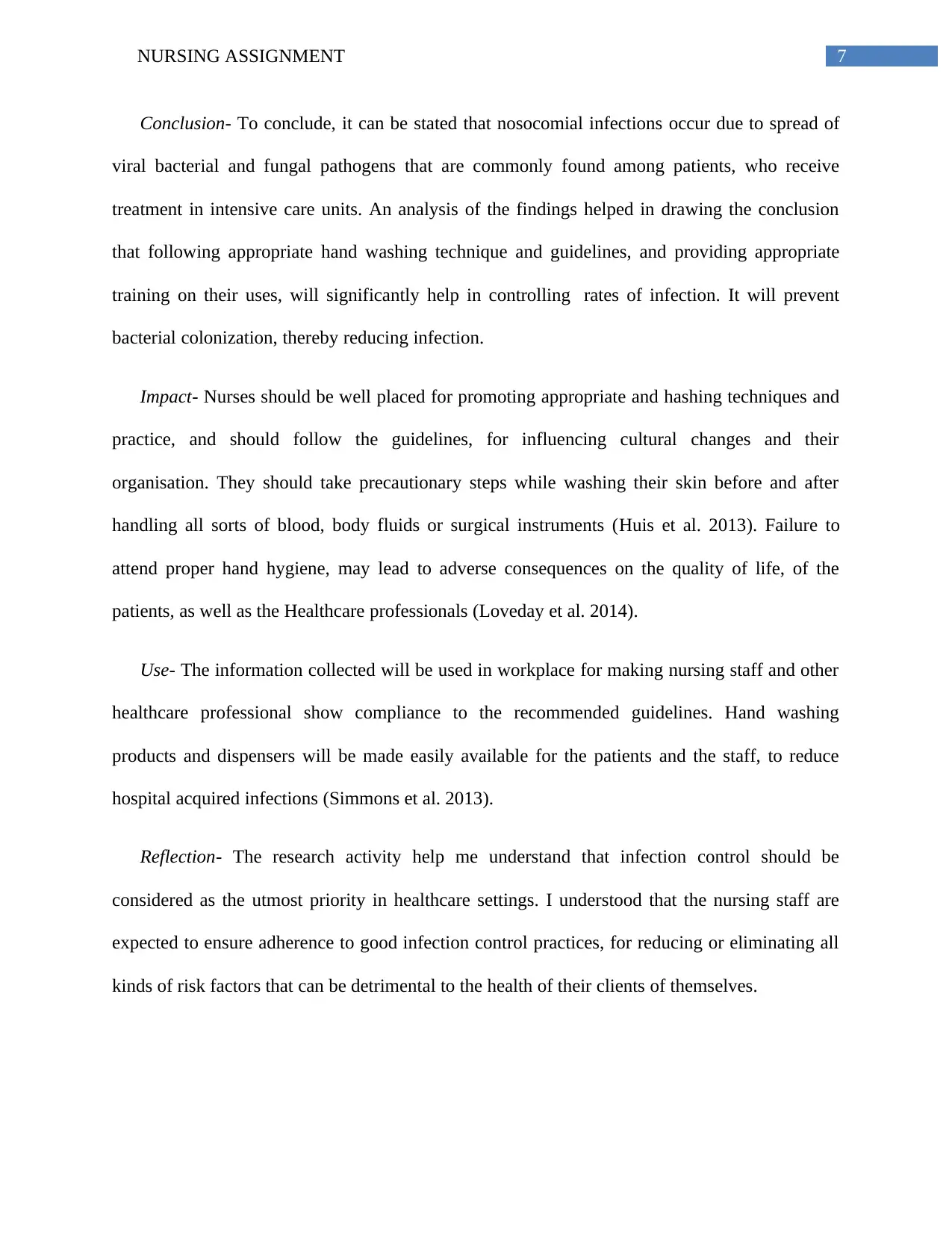
7NURSING ASSIGNMENT
Conclusion- To conclude, it can be stated that nosocomial infections occur due to spread of
viral bacterial and fungal pathogens that are commonly found among patients, who receive
treatment in intensive care units. An analysis of the findings helped in drawing the conclusion
that following appropriate hand washing technique and guidelines, and providing appropriate
training on their uses, will significantly help in controlling rates of infection. It will prevent
bacterial colonization, thereby reducing infection.
Impact- Nurses should be well placed for promoting appropriate and hashing techniques and
practice, and should follow the guidelines, for influencing cultural changes and their
organisation. They should take precautionary steps while washing their skin before and after
handling all sorts of blood, body fluids or surgical instruments (Huis et al. 2013). Failure to
attend proper hand hygiene, may lead to adverse consequences on the quality of life, of the
patients, as well as the Healthcare professionals (Loveday et al. 2014).
Use- The information collected will be used in workplace for making nursing staff and other
healthcare professional show compliance to the recommended guidelines. Hand washing
products and dispensers will be made easily available for the patients and the staff, to reduce
hospital acquired infections (Simmons et al. 2013).
Reflection- The research activity help me understand that infection control should be
considered as the utmost priority in healthcare settings. I understood that the nursing staff are
expected to ensure adherence to good infection control practices, for reducing or eliminating all
kinds of risk factors that can be detrimental to the health of their clients of themselves.
Conclusion- To conclude, it can be stated that nosocomial infections occur due to spread of
viral bacterial and fungal pathogens that are commonly found among patients, who receive
treatment in intensive care units. An analysis of the findings helped in drawing the conclusion
that following appropriate hand washing technique and guidelines, and providing appropriate
training on their uses, will significantly help in controlling rates of infection. It will prevent
bacterial colonization, thereby reducing infection.
Impact- Nurses should be well placed for promoting appropriate and hashing techniques and
practice, and should follow the guidelines, for influencing cultural changes and their
organisation. They should take precautionary steps while washing their skin before and after
handling all sorts of blood, body fluids or surgical instruments (Huis et al. 2013). Failure to
attend proper hand hygiene, may lead to adverse consequences on the quality of life, of the
patients, as well as the Healthcare professionals (Loveday et al. 2014).
Use- The information collected will be used in workplace for making nursing staff and other
healthcare professional show compliance to the recommended guidelines. Hand washing
products and dispensers will be made easily available for the patients and the staff, to reduce
hospital acquired infections (Simmons et al. 2013).
Reflection- The research activity help me understand that infection control should be
considered as the utmost priority in healthcare settings. I understood that the nursing staff are
expected to ensure adherence to good infection control practices, for reducing or eliminating all
kinds of risk factors that can be detrimental to the health of their clients of themselves.
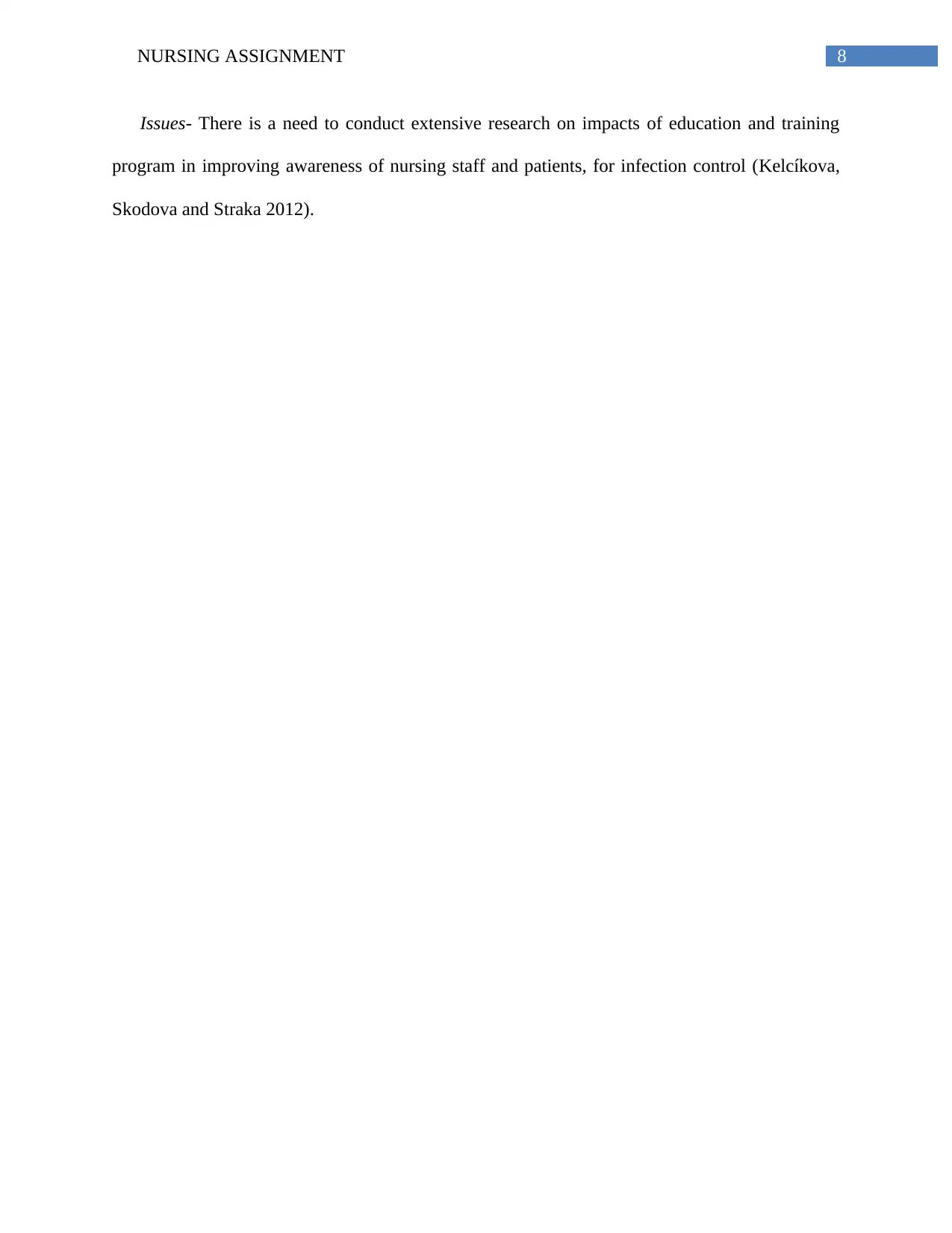
8NURSING ASSIGNMENT
Issues- There is a need to conduct extensive research on impacts of education and training
program in improving awareness of nursing staff and patients, for infection control (Kelcíkova,
Skodova and Straka 2012).
Issues- There is a need to conduct extensive research on impacts of education and training
program in improving awareness of nursing staff and patients, for infection control (Kelcíkova,
Skodova and Straka 2012).
⊘ This is a preview!⊘
Do you want full access?
Subscribe today to unlock all pages.

Trusted by 1+ million students worldwide
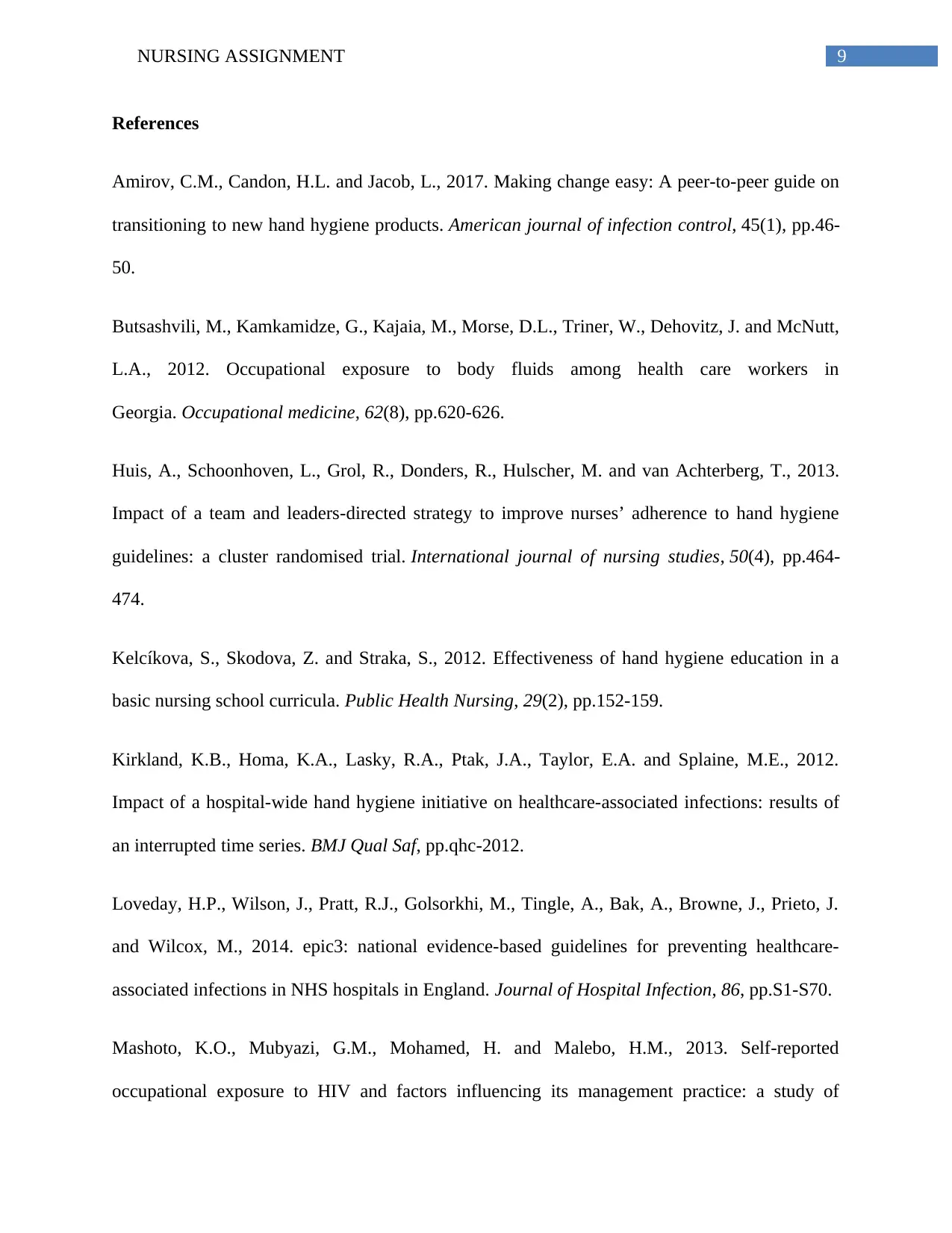
9NURSING ASSIGNMENT
References
Amirov, C.M., Candon, H.L. and Jacob, L., 2017. Making change easy: A peer-to-peer guide on
transitioning to new hand hygiene products. American journal of infection control, 45(1), pp.46-
50.
Butsashvili, M., Kamkamidze, G., Kajaia, M., Morse, D.L., Triner, W., Dehovitz, J. and McNutt,
L.A., 2012. Occupational exposure to body fluids among health care workers in
Georgia. Occupational medicine, 62(8), pp.620-626.
Huis, A., Schoonhoven, L., Grol, R., Donders, R., Hulscher, M. and van Achterberg, T., 2013.
Impact of a team and leaders-directed strategy to improve nurses’ adherence to hand hygiene
guidelines: a cluster randomised trial. International journal of nursing studies, 50(4), pp.464-
474.
Kelcíkova, S., Skodova, Z. and Straka, S., 2012. Effectiveness of hand hygiene education in a
basic nursing school curricula. Public Health Nursing, 29(2), pp.152-159.
Kirkland, K.B., Homa, K.A., Lasky, R.A., Ptak, J.A., Taylor, E.A. and Splaine, M.E., 2012.
Impact of a hospital-wide hand hygiene initiative on healthcare-associated infections: results of
an interrupted time series. BMJ Qual Saf, pp.qhc-2012.
Loveday, H.P., Wilson, J., Pratt, R.J., Golsorkhi, M., Tingle, A., Bak, A., Browne, J., Prieto, J.
and Wilcox, M., 2014. epic3: national evidence-based guidelines for preventing healthcare-
associated infections in NHS hospitals in England. Journal of Hospital Infection, 86, pp.S1-S70.
Mashoto, K.O., Mubyazi, G.M., Mohamed, H. and Malebo, H.M., 2013. Self-reported
occupational exposure to HIV and factors influencing its management practice: a study of
References
Amirov, C.M., Candon, H.L. and Jacob, L., 2017. Making change easy: A peer-to-peer guide on
transitioning to new hand hygiene products. American journal of infection control, 45(1), pp.46-
50.
Butsashvili, M., Kamkamidze, G., Kajaia, M., Morse, D.L., Triner, W., Dehovitz, J. and McNutt,
L.A., 2012. Occupational exposure to body fluids among health care workers in
Georgia. Occupational medicine, 62(8), pp.620-626.
Huis, A., Schoonhoven, L., Grol, R., Donders, R., Hulscher, M. and van Achterberg, T., 2013.
Impact of a team and leaders-directed strategy to improve nurses’ adherence to hand hygiene
guidelines: a cluster randomised trial. International journal of nursing studies, 50(4), pp.464-
474.
Kelcíkova, S., Skodova, Z. and Straka, S., 2012. Effectiveness of hand hygiene education in a
basic nursing school curricula. Public Health Nursing, 29(2), pp.152-159.
Kirkland, K.B., Homa, K.A., Lasky, R.A., Ptak, J.A., Taylor, E.A. and Splaine, M.E., 2012.
Impact of a hospital-wide hand hygiene initiative on healthcare-associated infections: results of
an interrupted time series. BMJ Qual Saf, pp.qhc-2012.
Loveday, H.P., Wilson, J., Pratt, R.J., Golsorkhi, M., Tingle, A., Bak, A., Browne, J., Prieto, J.
and Wilcox, M., 2014. epic3: national evidence-based guidelines for preventing healthcare-
associated infections in NHS hospitals in England. Journal of Hospital Infection, 86, pp.S1-S70.
Mashoto, K.O., Mubyazi, G.M., Mohamed, H. and Malebo, H.M., 2013. Self-reported
occupational exposure to HIV and factors influencing its management practice: a study of
Paraphrase This Document
Need a fresh take? Get an instant paraphrase of this document with our AI Paraphraser
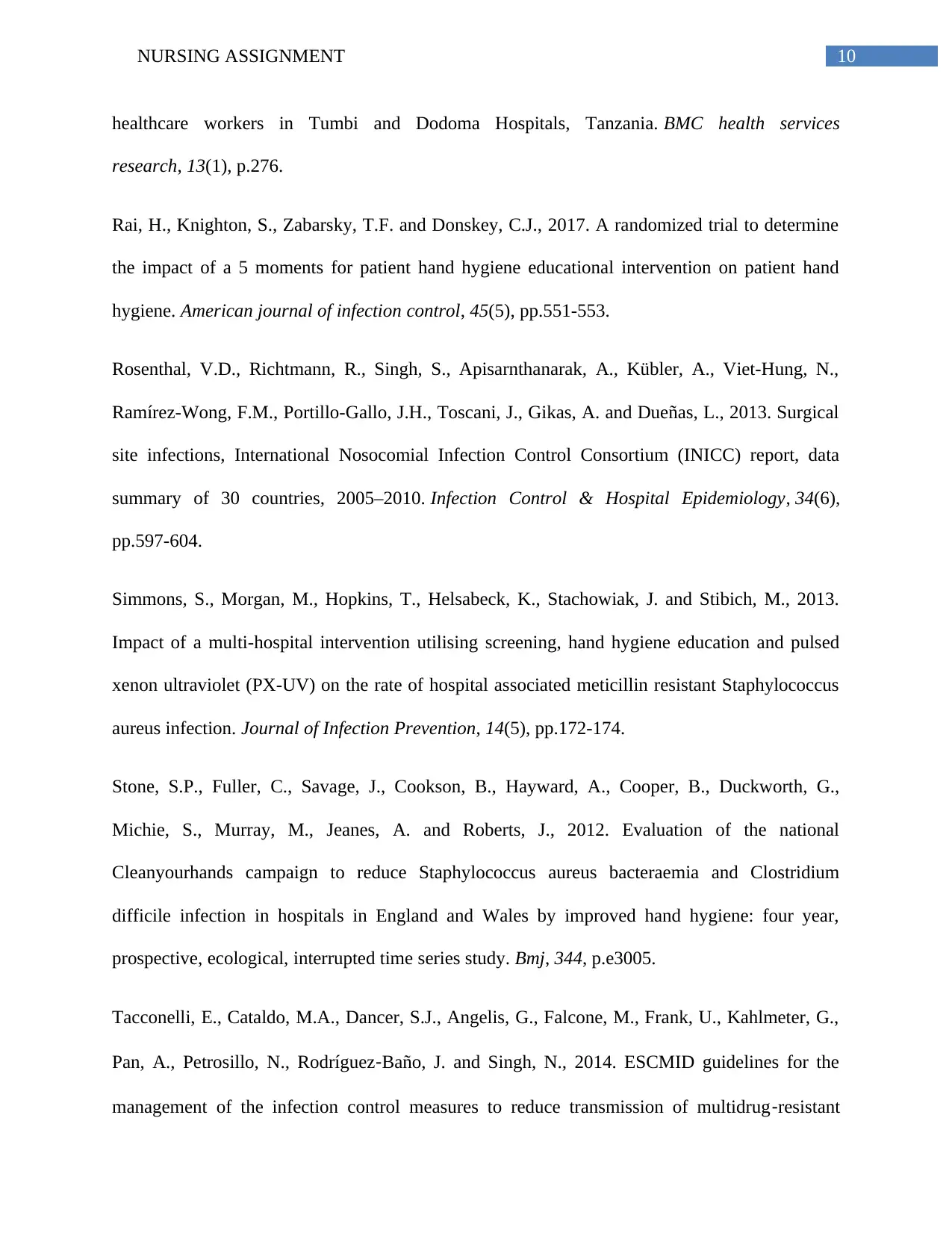
10NURSING ASSIGNMENT
healthcare workers in Tumbi and Dodoma Hospitals, Tanzania. BMC health services
research, 13(1), p.276.
Rai, H., Knighton, S., Zabarsky, T.F. and Donskey, C.J., 2017. A randomized trial to determine
the impact of a 5 moments for patient hand hygiene educational intervention on patient hand
hygiene. American journal of infection control, 45(5), pp.551-553.
Rosenthal, V.D., Richtmann, R., Singh, S., Apisarnthanarak, A., Kübler, A., Viet-Hung, N.,
Ramírez-Wong, F.M., Portillo-Gallo, J.H., Toscani, J., Gikas, A. and Dueñas, L., 2013. Surgical
site infections, International Nosocomial Infection Control Consortium (INICC) report, data
summary of 30 countries, 2005–2010. Infection Control & Hospital Epidemiology, 34(6),
pp.597-604.
Simmons, S., Morgan, M., Hopkins, T., Helsabeck, K., Stachowiak, J. and Stibich, M., 2013.
Impact of a multi-hospital intervention utilising screening, hand hygiene education and pulsed
xenon ultraviolet (PX-UV) on the rate of hospital associated meticillin resistant Staphylococcus
aureus infection. Journal of Infection Prevention, 14(5), pp.172-174.
Stone, S.P., Fuller, C., Savage, J., Cookson, B., Hayward, A., Cooper, B., Duckworth, G.,
Michie, S., Murray, M., Jeanes, A. and Roberts, J., 2012. Evaluation of the national
Cleanyourhands campaign to reduce Staphylococcus aureus bacteraemia and Clostridium
difficile infection in hospitals in England and Wales by improved hand hygiene: four year,
prospective, ecological, interrupted time series study. Bmj, 344, p.e3005.
Tacconelli, E., Cataldo, M.A., Dancer, S.J., Angelis, G., Falcone, M., Frank, U., Kahlmeter, G.,
Pan, A., Petrosillo, N., Rodríguez‐Baño, J. and Singh, N., 2014. ESCMID guidelines for the
management of the infection control measures to reduce transmission of multidrug‐resistant
healthcare workers in Tumbi and Dodoma Hospitals, Tanzania. BMC health services
research, 13(1), p.276.
Rai, H., Knighton, S., Zabarsky, T.F. and Donskey, C.J., 2017. A randomized trial to determine
the impact of a 5 moments for patient hand hygiene educational intervention on patient hand
hygiene. American journal of infection control, 45(5), pp.551-553.
Rosenthal, V.D., Richtmann, R., Singh, S., Apisarnthanarak, A., Kübler, A., Viet-Hung, N.,
Ramírez-Wong, F.M., Portillo-Gallo, J.H., Toscani, J., Gikas, A. and Dueñas, L., 2013. Surgical
site infections, International Nosocomial Infection Control Consortium (INICC) report, data
summary of 30 countries, 2005–2010. Infection Control & Hospital Epidemiology, 34(6),
pp.597-604.
Simmons, S., Morgan, M., Hopkins, T., Helsabeck, K., Stachowiak, J. and Stibich, M., 2013.
Impact of a multi-hospital intervention utilising screening, hand hygiene education and pulsed
xenon ultraviolet (PX-UV) on the rate of hospital associated meticillin resistant Staphylococcus
aureus infection. Journal of Infection Prevention, 14(5), pp.172-174.
Stone, S.P., Fuller, C., Savage, J., Cookson, B., Hayward, A., Cooper, B., Duckworth, G.,
Michie, S., Murray, M., Jeanes, A. and Roberts, J., 2012. Evaluation of the national
Cleanyourhands campaign to reduce Staphylococcus aureus bacteraemia and Clostridium
difficile infection in hospitals in England and Wales by improved hand hygiene: four year,
prospective, ecological, interrupted time series study. Bmj, 344, p.e3005.
Tacconelli, E., Cataldo, M.A., Dancer, S.J., Angelis, G., Falcone, M., Frank, U., Kahlmeter, G.,
Pan, A., Petrosillo, N., Rodríguez‐Baño, J. and Singh, N., 2014. ESCMID guidelines for the
management of the infection control measures to reduce transmission of multidrug‐resistant
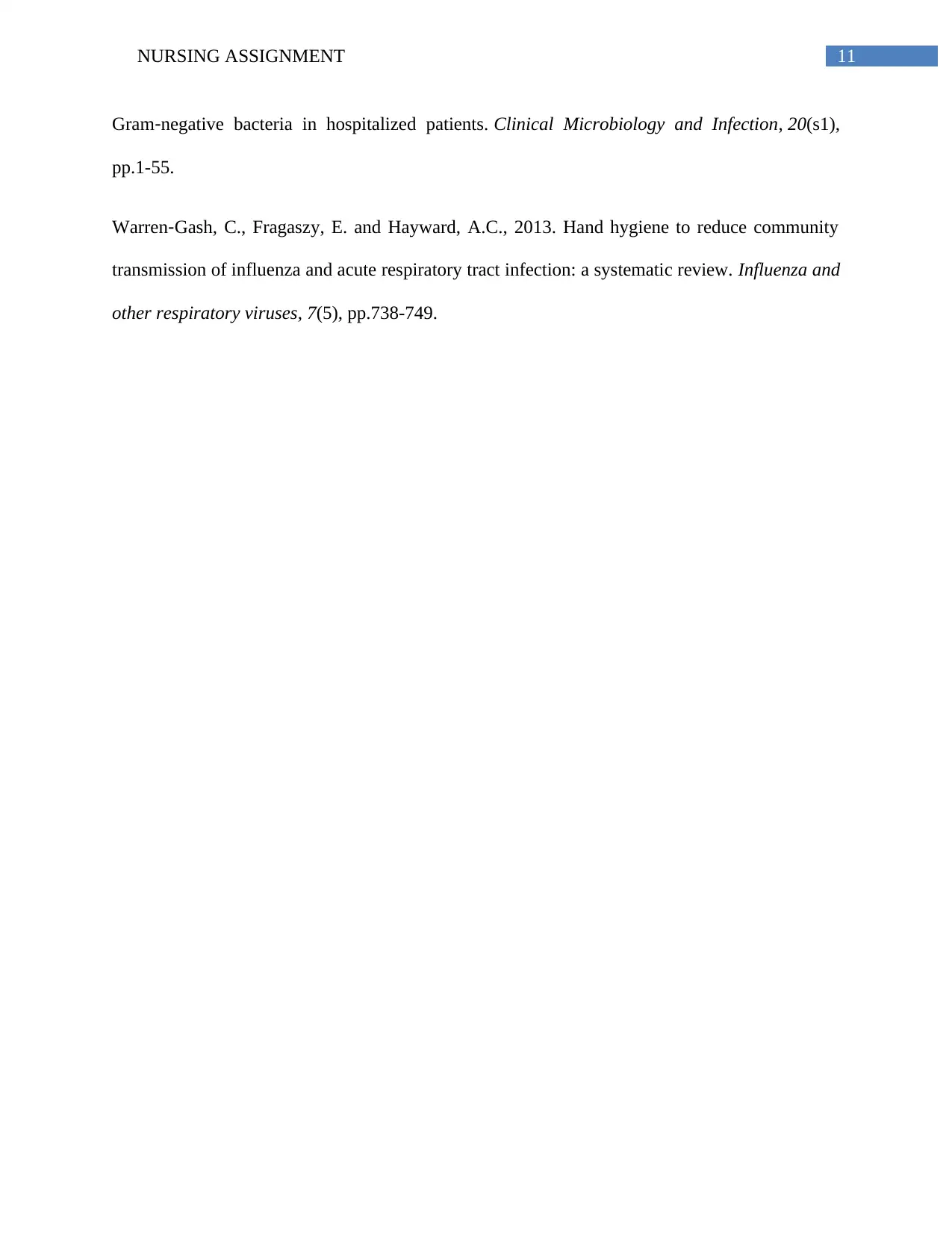
11NURSING ASSIGNMENT
Gram‐negative bacteria in hospitalized patients. Clinical Microbiology and Infection, 20(s1),
pp.1-55.
Warren‐Gash, C., Fragaszy, E. and Hayward, A.C., 2013. Hand hygiene to reduce community
transmission of influenza and acute respiratory tract infection: a systematic review. Influenza and
other respiratory viruses, 7(5), pp.738-749.
Gram‐negative bacteria in hospitalized patients. Clinical Microbiology and Infection, 20(s1),
pp.1-55.
Warren‐Gash, C., Fragaszy, E. and Hayward, A.C., 2013. Hand hygiene to reduce community
transmission of influenza and acute respiratory tract infection: a systematic review. Influenza and
other respiratory viruses, 7(5), pp.738-749.
⊘ This is a preview!⊘
Do you want full access?
Subscribe today to unlock all pages.

Trusted by 1+ million students worldwide
1 out of 14
Related Documents
Your All-in-One AI-Powered Toolkit for Academic Success.
+13062052269
info@desklib.com
Available 24*7 on WhatsApp / Email
![[object Object]](/_next/static/media/star-bottom.7253800d.svg)
Unlock your academic potential
Copyright © 2020–2025 A2Z Services. All Rights Reserved. Developed and managed by ZUCOL.




